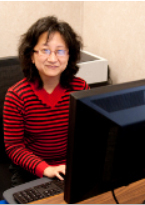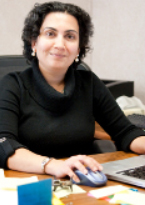
Dr. Janusz Wojtusiak

Dr. Hua Min

Dr. Priya Nambisan

Dr. Phan Giang
February 9, 2012 - Old hard-drives line the top of bookshelves in Dr. Janusz Wojtusiak’s office, some as small as a deck of cards, others as big as the final Harry Potter tome. You might not know it to look at them, but those ubiquitous beige boxes represent both the history and the future of one of the simplest, yet most daunting challenges for modern health care—the sharing of information via technology.
"What is the field of health informatics?" Dr. Wojtusiak, the Director of George Mason University’s Center for Discovery Science and Health Informatics (HI) taps thin fingers together and ponders the question. "At its most basic level, we’re studying the intersection of technology and health information, but not to the exclusion of either." After getting his Masters in Computer Science from Jagiellonian University in his native Poland, Dr. Wojtusiak moved to America, where he received his Ph.D. in Computational Sciences and Informatics from GMU. Traces of his native accent enter his explanation as he leans forward. "We’re studying and innovating the way that important data are communicated in health care, the way that information flows, and ways in which technology can become smarter to help in the process."
Dr. Janusz Wojtusiak
But surely doctors and nurses share information with each other all the time, right? Would that were so, asserts his colleague, Dr. Hua Min, radiating a warm smile from behind her wire-frame glasses. And even when health care professionals do share information, there are a number of unique challenges in that communication—not the least of which is the actual meaning of the words themselves. In a quiet, but firm voice she illustrates the problem. "Let’s say you overhear a conversation between two people, and they keep using the word apple. Are they talking about fruit, or about computers? If you’re on the street, usually the context isn’t that difficult to parse. But when it comes to sprawling databases of medical records…well, it’s a lot more complicated."
After studying medicine in China, Dr. Min first moved to America to study health informatics in the late nineties, where she received both her Masters and Ph.D. in health-care oriented Computer Science from the New Jersey Institute of Technology. A long- time collaborator with the National Cancer Institute, she shares, "We often see difficulties in cancer drug trials where researchers in one lab may come up with new terms to describe a phenomenon that’s already been recorded with different terms in a different clinical trial just a year or two earlier. To help researchers make progress in the most expedient way possible, we simply have to ensure that we keep finding ways to link the old and the new."
Dr. Hua Min
It is basic communication difficulties like this that are also surprisingly common outside of clinical research, according to Dr. Priya Nambisan, who formerly served as a public health coordinator for the Government of Singapore after receiving her Ph.D. in Communication and Technology from Rensselaer Polytechnic Institute. "It’s part of what makes it difficult for the ER doctor you consulted when you broke your foot on vacation to pass on the information to the new family physician you recently began visiting back home." She crosses her arms calmly and continues. "Both their terminology and their technology might be completely different. The solution is that health care providers need to agree on national standards."
Dr. Min agrees, adding, "This is why different doctors are always insisting on administering the same test themselves. We need standards for the standards! Right now, in an already maxed out health care provider system, doctors are increasingly failing to consult the labyrinth of prior physician-entered electronic medical records (EMRs) at hospitals—let alone patient-provided personal health records (PHRs)—because of the over-abundance of information and the difficulties in deciphering them." In addition to repeating tests, physicians rely on the patients’ oral accounts. "They often find the fastest way to proceed is to simply ask patients basic questions like are you allergic to anything? before proceeding. It’s a process fraught with the possibility of miscommunication or inadvertent oversight."
Dr. Priya Nambisan
The sheer amount of information recorded in today’s medical environment is an equally daunting challenge. The fourth member of the GMU health informatics team, Dr. Giang, points out that that we generate literally "billions of pages of clinical text each year in the U.S." Yet, with the average clinician having less than seven minutes to consult patient records, they often only skim the surface of the recorded data. What if they had computer tools to help them analyze the data?
"It’s relatively easy for computers to report unambiguous information—structure data—such as height and weight," Dr. Giang states. "Where it gets tricky is with diagnoses and other physician variable terms—clinical text." This as Dr. Min shared, can contain a great variety in terminology. To successfully analyze clinical text is hugely challenging and goes far beyond searching for "key words;" it requires the intelligent analysis of many contextual terminologies. "One of the goals here at the HI program is to bring as much of that clinical text into the structure data, so that our software models can more easily and accurately interpret the data."
Textual processing isn’t the only kind of health informatics that interests Dr. Giang, who studied in Kansas, Australia, and Russia before coming to GMU. He is also researching "decision making and uncertainty" as it relates to scenarios like the depression and suicide rates of veterans from Iraq and Afghanistan, which are alarmingly high. "How do doctors address this challenge? Primarily, at the moment, by prescribing anti-depressants." Dr. Giang’s eyebrows rise above his stylish glasses. "Where the uncertainty in this scenario comes in, however, is these medications haven’t necessarily been tested on that population. For example, an African-American soldier may react rather differently than the suburban white woman a medication may have been tested on. We have the efficacy and knowledge for one population, but not for the other." In response, Dr. Giang’s studies attempt to analyze and rate the uncertain factors so that patients and their healthcare providers can more efficiently decide on the most appropriate course of action.
"The need for research and innovation in the way we share information via technology is growing by the week," asserts Dr. Wojtusiak. Accordingly, Mason now offers a newly approved 34-credit Master in Health Informatics degree. This program replaces the previous successful concentration under health systems management program and is designed to balance theoretical knowledge with practical experience.
"Most of the people who work in the field or study it are not computer programmers; rather, they’re health care professionals who share a common passion for harnessing technology to help aid communication in the field. There is, however, an urgent need to train people whose knowledge intersects the two disciplines: healthcare and computer science." To that end, instructors and students alike typically use open-source software to avoid confusion with the other "500+ different options out there," analyzing both EMRs and PHRs as they examine the best ways to interact with patient information. "We teach how things work, not how to use specific commercial tools." Of course, sharing information is just part of the problem. Mirroring the rise of the digitization of data is an exponential increase of the amount of information. "Health care information is the most diverse and complex data out there," confesses Dr. Wojtusiak and his colleagues nod their agreement.
It’s in response to that challenge that he runs the GMU Machine Learning and Inference Laboratory (MLI) as part of the Health Informatics Center. Of course, the patient information that can now be entered is far more than just disease codes on a patient’s electronic record keyed into a computer terminal—more and more unstructured data sets, such as physician notes, and images, are also recorded. At the MLI, Dr. Wojtusiak works with graduate students to develop learning algorithms to analyze complex healthcare data culled from computer databases, and new methodologies to compare data from published studies with the latest patient information. "Our goal is to create methods that use all available information, not only clean datasets collected in controlled environment," says Wojtusiak. "Information comes from clinical trials, patient records, published studies, public health datasets, existing terminologies, and do on. The challenge is how to use all of that." One such study is examining the feasibility of predicting payments of medical claims by analyzing patterns of how insurance companies (who often determine the affordability of treatment) respond to specific billing information.
Dr. Nambisan, on the other hand, has worked for years on analyzing the ways that patients communicate with health care providers online, from forums to social media interaction. One of the projects that she is currently leading at GMU is research on improving the way that PHRs are handled. With a team of students, she is working on the development of a software program to allow patients to carry their own PHRs with them everywhere on their mobile electronic devices. "With an easily available app, patients could now carry extensive, but private, password-protected medical histories with them everywhere they went." She shows off the beta interface design of the program, noting its familiar search capabilities, cross-indexing, and term definitions. It’s clear that such an app could revolutionize the way both patients and physicians interact with health care records. The interest in such a tool is high, Dr. Nambisan shares; "companies as big as Google and Microsoft have offered up new programs for PHRs. However, no one has fully harnessed mobile electronics as of yet. More importantly, they haven’t offered anything in the way of standardizing the terminology in the records." Everyone else agrees, once again. Standards are absolutely vital for accurate, easy search capability.
Each student who graduates from the Health Informatics program at Mason finishes his or her master’s degree with a practicum, guaranteeing invaluable hands-on experience in real environment. A specialized project that is much more than an internship: past practicums have included building a specialized database for the Veterans Administration and combining data from multiple sites for the Joint Commission, which accredits health care providers. "It’s this kind of opportunity that distinguishes Mason’s Health Informatics program," says Wojtusiak, and "the way it integrates multidisciplinary faculty. Other programs focus on simply teaching how to use information systems. We take a much broader approach that considers policy-making, economics, research, and more—all the while combining theoretical and practical approaches."
It’s clear that the challenges and the opportunities of harnessing information are many in the health care field. "Right now, there are about fifty students in Mason’s program—and there is a mountain of data out there that needs to be managed." Dr. Wojtusiak leans back in his chair and gestures broadly in a move that encapsulates all of the conversation, even as it does all the hard-drives lining the room. "We expect that number to grow substantially," he concludes simply.
Written by Josh Ambrose.
Dr. Phan Giang
